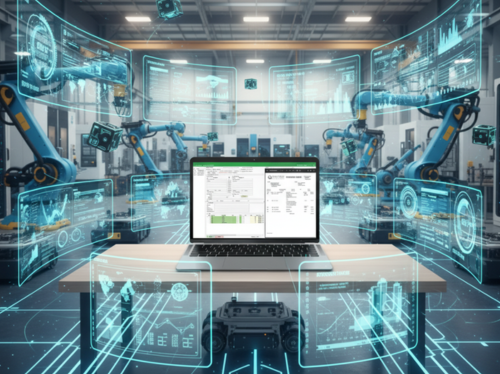Motorcycle accessories manufacturer increases automated production of prismatic components

Established in 2003 as a subcontractor, Drury Precision Engineering started two years later to manufacture its own range of mainly aluminium motorcycle accessories for road and racing bikes and now no longer takes on external machining work. The company sells its after-market bike components globally under the Evotech Performance brand. The last eight years have seen exceptional year-on-year growth in turnover that has necessitated careful planning of production capacity on the shop floor to keep pace with demand.
A user since 2015 of 16,000 rpm, high efficiency machining centres from Brother, Japan, supplied through sole UK and Ireland agent Whitehouse Machine Tools, Drury has over the years used various manually operated, twin automatic pallet change (2APC) models of the 3-axis, 30-taper, machines, of which only two remain. That is because, to raise throughput, the company decided in 2015 to transition to automated Brother production cells with the purchase of two 5-axis Speedio M140X2s.
One was equipped with a Brother four-metre Feedio vision-based, robotic component handling system, while the other was connected to a System 3R WorkPartner Plus storage and handling system accommodating 180 pallets. The latter cell targeted Op 20 inefficiencies within the factory and was set up so that both Op 10 and Op 20 could be completed automatically for six motorbike parts in left- and right-handed versions, unattended for up to 20 hours.
Now the company has gone a step further along the automation route with the installation in March 2023 of a larger capacity Brother Speedio U500Xd1 5-axis machining centre with pneumatically-operated zero-point pallet location, again served by a WorkPartner Plus storage and handling system, but this time for 60 heavy-duty pallets.
It proved so successful that a second, almost identical cell has been ordered for delivery in October 2024, complete with its own WorkPartner Plus, as sharing one storage system between the two machines would reduce unmanned running hours to below the required 14 hours per machine.
The only difference with the second U500Xd1 is that it will be fitted with Brother’s latest D00 CNC system with a 15-inch screen, monitoring of automatic tool change and machine load, and most importantly capability for full 5-axis machining, whereas the control on first machine interpolates only four axes simultaneously.
Nick Cooper, the director in charge of machining who runs the company with partners Dan Rack and Chris Vines, commented, “These latest Brother machines have a larger working volume than the M140X2’s, so we can produce bigger components like crash protection products and some tail tidy parts completely in two operations.”
Drury is a power user of Brother machines that has the ear of the Japanese manufacturer via WMT CNC. Suggestions made have been incorporated into the U500Xd1, one of which was to raise the tool capacity in the turret from 21, as in Brother M-series machines, to 28. Mr Cooper describes this as a massive benefit, as more jobs can be produced without retooling and there is extra space for sister tool exchange during unattended production.

Another benefit of having more cutters available is that additional refinements can be machined into the bike components so that reverse engineering and copying of Evotech Performance products by unscrupulous overseas companies becomes more difficult. The time lost by introducing a couple of additional tool changes is minimal, as exchange time is 0.6 second and chip-to chip is only double that, while spindle acceleration to 16,000 rpm is blisteringly fast at 0.2 second. Full 5-axis interpolation on the next U500Xd1 will further expand the introduction of design enhancements and will also present opportunities to decrease component size and weight.
As with all but the earliest Brother machine on the Alford site, the latest U-series machine has been delivered with a BIG Plus face-and-taper contact spindle interface, providing rigidity for achieving excellent surface finish. Cosmetic appearance of Evotech Performance products is an important criterion for brand reputation and maximising sales.
In some ways, Drury is a victim of its own success. Where the early product range was mainly restricted to tail tidies, radiator guards and crash protection items, more recently satnav mounts and guards for brakes and headlights have been added. The company already has a large number parts on its system and a recent doubling of in-house designers to four means that the number will grow ever more quickly. Hundreds of new products are introduced every year, but those discontinued are counted in tens.
The earlier production strategy in Alford was to maximise Op 10 cycle time in the first two automated Brother cells and minimise Op 20 for completion on manually loaded machines. To illustrate the disparity between the operations, Op 10 for a BMW tail tidy is 40 minutes whereas Op 20 is just 50 seconds. Re-engineering all existing jobs to equalise the operations for automated manufacture would be too time-consuming and will only be done in a few cases, hence the decision to retain the two Brother APC machines without automation.
The future for Drury is to increase the complete manufacture of components in automated production cells using balanced operations and this is how future jobs will be programmed. The company already uses a pair of HSK-25, 40,000 rpm gantry mills for particularly intricate work and Mr Cooper is currently investigating with WMT CNC the potential use of a high-speed electric spindle on the Brother machines. It will save wear on the machining centre spindles when using small diameter ball nose cutters to scan fine surface finishes during cycles that improve the cosmetic appearance of the bike after-market products.








